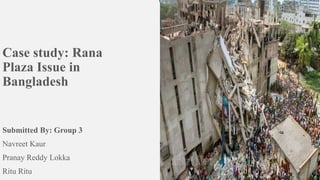
Case study.pptx
- 1. Case study: Rana Plaza Issue in Bangladesh Submitted By: Group 3 Navreet Kaur Pranay Reddy Lokka Ritu Ritu
- 2. Overview: Each infrastructure project, whether it be a tower, a tunnel, or another kind, entails some level of risk. The project leader has a significant impact on how a building project manages risk. Nevertheless, a suitable as well as structured procedure, understanding, as well as skill set are necessary for an efficient & suitable risk management strategy (Alfredo Federico Serpella, 2014). The objective of this article is to use Analytical Hierarchy Process analysis (AHP) to clearly identify threats inside a construction phase as well as to determine how to minimise or decrease those hazards. The entire technique is explained using the specific example of the Bangladeshi construction accidents known as Rana Plaza. The pile foundation, order fulfillment, and architectural engineering present the biggest risks for Rana Plaza. We discover across AHP assessment that perhaps the base framework is responsible for the implosion of Rana Plaza.
- 3. Risk management: The recognition, analyzation, and reaction to adverse outcomes that seem to be inherent in a country's financial system are all included in risk management. Successful risk management understanding in order consciously instead of responsively inside an effort to influence potential results in any way potential. As a result, good risk management has the ability to lessen both the likelihood of a risk happening as well as its possible repercussions. RISK MANAGEMENT:
- 4. Savar's Rana Plaza was really a nine-story structure that accomodated five textile mills, a mortgage company, and a town center.The building fell on April 24, 2013, having killed 1100 employees and wounding 2500 quite.
- 5. • First bullet point here • Second bullet point here • Third bullet point here Class Group A Group B Class 1 82 95 Class 2 76 88 Class 3 84 90 Despite the fact that the building had a crack throughout it, at the time of Rana Plaza's breakdown, the employees were still needed to perform their jobs in a dangerous environment.The employees had been warned that there own salaries would be withheld if they remained missing. Rana Plaza Tragedy:
- 6. Ethical Issues: Unethical practices in Rana Plaza Construction Irresponsiblity towards the crack identified in the walls
- 7. UNETHICAL PRACTICES IN RANA PLAZA CONSTRUCTION: Unauthorized construction added four more storeys. Poor components were used to create plazas There was a lack of adherence to federal national building code.
- 8. Add a Slide Title - 2 Unethical in the light of : Mill and Bentham’s Utilitarianism theory. Hobbes’s 2nd natural law says that we should keep promises and perform contracts on which we agree. Virtue theory’s implication in business. Hobbes’s 8th natural law says that we should not to do others, what we don’t want them to do to us. Legal Offense: The plaza has 4 storey registration but they make 9 storey plaza. Management’s point of view: According to Friedman’s view, the motive of the plaza is to create profit, so that they create 9 storey building instead of 4 storey building. Outsider’s View: Authority’s lack of inspection and its dishonesty by allowing construction. Management’s alternative actions: 1. Creating supporting walls for factory machines. 2. Strong material filled in the pond to create well maintained base. 3. For construction. Use of good quality material.
- 9. Irresponsibility towards the crack identified in the walls: Unethical in the light of: 1. Mill and Bentham’s utilitarianism theory. 2. Hobbes’s 4th and 8th natural law. 3. “Good ethics is also good business”, by: Solomon and Hanson. 4. Virtue theory’s implication in business. 5. Hobbes’s 8th natural law states that “we shoul not do to others when we don’t want them to do to us.”
- 10. Add a Slide Title - 4
- 12. Add a Slide Title - 5
- 13. Add a Slide Title - 6
- 14. Add a Slide Title - 7
Notes de l'éditeur
- To change the image on this slide, select the picture and delete it. Then click the Pictures icon in the placeholder to insert your own image.